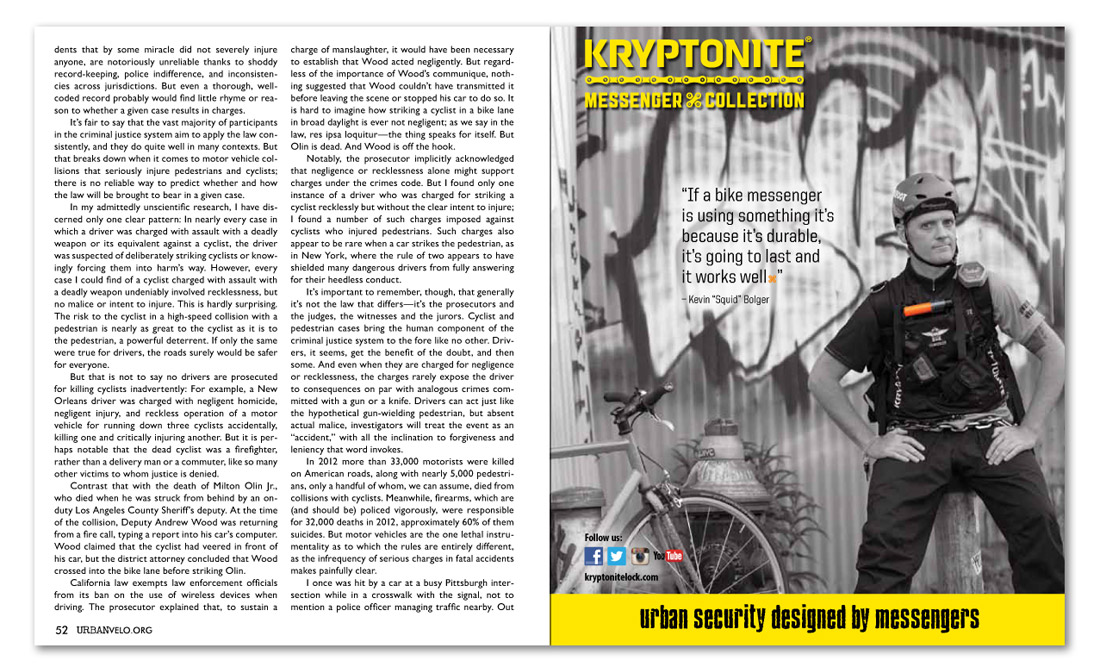dents that by some miracle did not severely injure anyone, are notoriously unreliable thanks to shoddy record-keeping, police indifference, and inconsistencies across jurisdictions. But even a thorough, well-coded record probably would find little rhyme or reason to whether a given case results in charges.
It’s fair to say that the vast majority of participants in the criminal justice system aim to apply the law consistently, and they do quite well in many contexts. But that breaks down when it comes to motor vehicle collisions that seriously injure pedestrians and cyclists; there is no reliable way to predict whether and how the law will be brought to bear in a given case.
In my admittedly unscientific research, I have discerned only one clear pattern: In nearly every case in which a driver was charged with assault with a deadly weapon or its equivalent against a cyclist, the driver was suspected of deliberately striking cyclists or knowingly forcing them into harm’s way. However, every case I could find of a cyclist charged with assault with a deadly weapon undeniably involved recklessness, but no malice or intent to injure. This is hardly surprising. The risk to the cyclist in a high-speed collision with a pedestrian is nearly as great to the cyclist as it is to the pedestrian, a powerful deterrent. If only the same were true for drivers, the roads surely would be safer for everyone.
But that is not to say no drivers are prosecuted for killing cyclists inadvertently: For example, a New Orleans driver was charged with negligent homicide, negligent injury, and reckless operation of a motor vehicle for running down three cyclists accidentally, killing one and critically injuring another. But it is perhaps notable that the dead cyclist was a firefighter, rather than a delivery man or a commuter, like so many other victims to whom justice is denied.
Contrast that with the death of Milton Olin Jr., who died when he was struck from behind by an on-duty Los Angeles County Sheriff’s deputy. At the time of the collision, Deputy Andrew Wood was returning from a fire call, typing a report into his car’s computer. Wood claimed that the cyclist had veered in front of his car, but the district attorney concluded that Wood crossed into the bike lane before striking Olin.
California law exempts law enforcement officials from its ban on the use of wireless devices when driving. The prosecutor explained that, to sustain a charge of manslaughter, it would have been necessary to establish that Wood acted negligently. But regardless of the importance of Wood’s communique, nothing suggested that Wood couldn’t have transmitted it before leaving the scene or stopped his car to do so. It is hard to imagine how striking a cyclist in a bike lane in broad daylight is ever not negligent; as we say in the law, res ipsa loquitur—the thing speaks for itself. But Olin is dead. And Wood is off the hook.
Notably, the prosecutor implicitly acknowledged that negligence or recklessness alone might support charges under the crimes code. But I found only one instance of a driver who was charged for striking a cyclist recklessly but without the clear intent to injure; I found a number of such charges imposed against cyclists who injured pedestrians. Such charges also appear to be rare when a car strikes the pedestrian, as in New York, where the rule of two appears to have shielded many dangerous drivers from fully answering for their heedless conduct.
It’s important to remember, though, that generally it’s not the law that differs—it’s the prosecutors and the judges, the witnesses and the jurors. Cyclist and pedestrian cases bring the human component of the criminal justice system to the fore like no other. Drivers, it seems, get the benefit of the doubt, and then some. And even when they are charged for negligence or recklessness, the charges rarely expose the driver to consequences on par with analogous crimes committed with a gun or a knife. Drivers can act just like the hypothetical gun-wielding pedestrian, but absent actual malice, investigators will treat the event as an “accident,” with all the inclination to forgiveness and leniency that word invokes.
In 2012 more than 33,000 motorists were killed on American roads, along with nearly 5,000 pedestrians, only a handful of whom, we can assume, died from collisions with cyclists. Meanwhile, firearms, which are (and should be) policed vigorously, were responsible for 32,000 deaths in 2012, approximately 60% of them suicides. But motor vehicles are the one lethal instrumentality as to which the rules are entirely different, as the infrequency of serious charges in fatal accidents makes painfully clear.
I once was hit by a car at a busy Pittsburgh intersection while in a crosswalk with the signal, not to mention a police officer managing traffic nearby. Out


